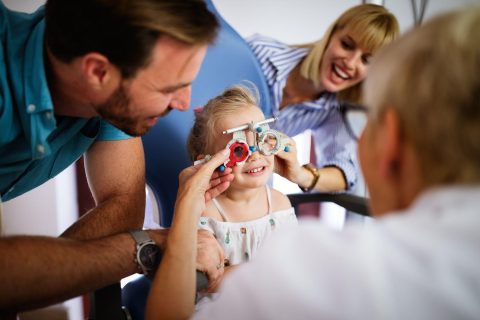Angie’s story: a new treatment for congenital cataracts
7 January 2020

Angie’s daughter, Hannah, was born with congenital cataracts. After struggling to find a treatment that worked, Moorfields helped them to access a new solution.
When Angie and Paul took Hannah home for the first time, they quickly realised something was wrong with her eyes.
The next day, a doctor visited the family and noticed that Hannah’s eyes were not responding normally.
The family visited a specialist at Great Ormond Street Hospital who told Angie and her husband that Hannah had developed congenital cataracts, and that she would need an operation to remove them.
What are congenital cataracts?
Learn more
Congenital cataracts are a form of cataract that affect children and babies, where the lens behind the pupil becomes cloudy, making it difficult to see clearly.
When a baby is born with a cataract it is called a ‘congenital cataract’. If a cataract develops in the first six months of life it is known as an ‘infantile cataract’.
Cataracts can affect one or both eyes and are caused by a genetic fault inherited from the parent, a genetic condition such as Down’s syndrome, infections or an injury.
As well as poor vision, cataracts can also cause children to develop a squint (where the eyes point in different directions) or ‘wobbly eyes’ (caused by a condition called nystagmus).
3-4 per 10,000
Around 3-4 out of every 10,000 children born have a cataract
Congenital cataracts do not always impact vision. However, if they do, the child may need surgery to remove their cataract(s). Once a cataract has been removed, it cannot grow back.
Hannah’s first operations
Hannah had her first operation at just six days old, shortly followed by another two days’ later. It was a frightening time for Angie and her husband: “We didn’t know what the future would hold.”
The operation went well, but just weeks later Angie and Paul discovered that Hannah also had glaucoma.
The doctors put Hannah on a course of eye drops and referred her to Moorfields Eye Hospital.
What is glaucoma?
Learn more
Glaucoma is a when damage to the optic nerve causes sight loss. It is usually caused by the pressure inside your eye rising too high.
Your eye is full of fluid, which helps it to keep its shape and function properly. If too much fluid builds up inside the eye, the pressure rises and squeezes the optic nerve at the back of the eye.
This can cause damage to your optic nerve - a bundle of over a million nerve fibres that carry signals between your eye and your brain.
Pressure might build up in the eye when:
- fluid is stopped from draining away
- extra fluid is produced after an eye injury or infection - this is called ‘secondary glaucoma’
- there is an abnormality in the shape of the eye in children - this is called ‘congenital glaucoma’.
Glaucoma tends to develop slowly over many years. As there is currently no cure for glaucoma, treatment focuses on early diagnosis, careful monitoring and regular treatment to help prevent further sight loss.
9 in 10
Over 90% of people diagnosed with glaucoma today who get the treatment they need will retain useful sight for the rest of their lives
It is not currently possible to repair the optic nerve once it has been damaged, so any vision lost to glaucoma cannot be recovered. If left untreated, glaucoma can lead to blindness.
There are usually no symptoms of a rising pressure in the eye until sight loss occurs, so regular eye tests are the best way to help spot the condition early.
Treating Hannah’s glaucoma at Moorfields
When they arrived, Angie and her husband met the team who would help them through the years to come.
Moorfields always went the extra mile for us. Their care and attention was second to none.
Over time, Hannah’s eye drops stopped working and she needed further operations to reduce the pressure in her eyes.
These worked for a while but, when she was four, Hannah went completely blind in her left eye.
Something had to change. Hannah’s doctor recommended trying a brand new treatment called a Molteno tube. It was a progressive idea - Hannah would be one of the first children in the UK to have it.
The operation was a huge success. Not only did the Molteno tube improve Hannah’s condition, but it also meant that the family could spend more time together at home instead of travelling back and forth across the country for appointments at Moorfields.
Bouncing back
Even though Hannah had her fair share of difficulties, she never wanted to let them slow her down.
Once her glaucoma was under control, she joined her local gymnastics club with her sister and took swimming lessons with the help of prescription goggles.
At 13, she had a contact lens made for her right eye which meant she could have normal prescription reading glasses.
Angie is incredibly grateful for their family’s experience with Moorfields and that Hannah has been able to live life to the full.
Hannah has developed into a beautiful, funny, confident and very talented 23-year-old. She has never let her limited vision stop her doing anything she sets her mind to. We are so proud of everything she does.
Angie

